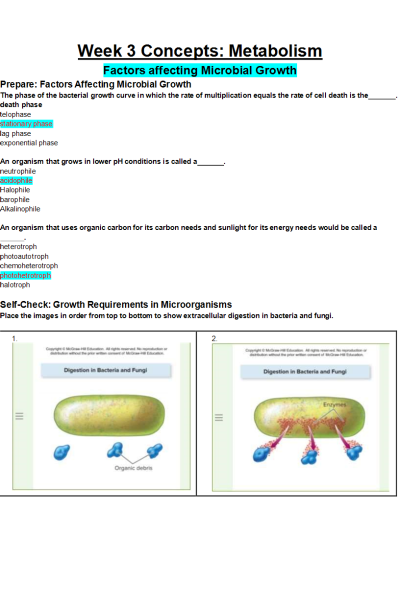BIOS 242 Week 3 Concepts; Metabolism
-
$15.00
| Institution | BIOS 242 Fundamentals of Microbiology with Lab - Chamberlain |
| Contributor | Anika Fultz |
Week 3 Concepts: Metabolism
Factors affecting Microbial Growth
Prepare: Factors Affecting Microbial Growth
- The phase of the bacterial growth curve in which the rate of multiplication equals the rate of cell death is the . death phase
- An organism that grows in lower pH conditions is called a .
- An organism that uses organic carbon for its carbon needs and sunlight for its energy needs would be called a
- .
Self-Check: Growth Requirements in Microorganisms
- Place the images in order from top to bottom to show extracellular digestion in bacteria and fungi.
Self-Check: Sources of Energy
- Which type of organism will acquire energy from light and acquire nutrients via catabolism of organic compounds.
- Which type of organism will acquire energy and Carbon via catabolism of organic compounds.
Self-Check: Identify the Organism
- Organisms that live on dead animals and plants and digest food by secreting enzymes are called .
Self-Check: Transport Processes
- Which type of solution will result in water entering the cell?
Self-Check: Temperature Requirements
- Microorganisms that have a requirement for growth below 15°C are called .
Self-Check: Patterns of Oxygen Utilization
- Which thioglycolate tube shows the growth of an obligate anaerobe.
Self-Check: Population Growth
- Which phase of growth has limited nutrients and exponential death of cells?
Self-Check: Phases of Population Growth
- Match the following items to their corresponding description.
Reflect: Factors Affecting Microbial Growth
- The methanogens, producers of methane gas, require environments that __________
- The phase of the bacterial growth curve that shows the maximum rate of cell division is the __________ .
- Bacteria living in a freshwater stream that are transferred to ocean water would __________
- A saprobe differs from a parasite in that __________
- An organism that uses CO2 for its carbon needs and sunlight for its energy needs would be called a __________ .
- Match the following terms to their corresponding description.
- An organism with a temperature growth range of 45°C to 60°C would be called a(n) __________ .
Enzymes
Prepare: Enzymes
- Enzymes that function inside a cell are .
- Enzymes can be regulated.
- The term used to describe all of the chemical reactions within a cell is .
- Enzymes are composed of
Self-Check: The Role of Enzymes
Self-Check: Factors Affecting Enzyme Activity
- Which of the following affect enzyme activity?
Self-Check: Enzyme Structure
- Holoenzymes _____
Self-Check: Naming Enzymes
- Select the correct class for each drop-down based on the substrates and action provided.
Self-Check: Enzyme Location
- Your bacterium is growing on a type of medium called casein agar, which contains milk protein (casein). There is a clear zone around the growth area of the bacterium, showing that it is synthesizing the enzymes needed to catalyze the extracellular breakdown of casein. These enzymes are considered .
Self-Check: Enzyme Regulation
- Constitutive enzymes ____ .
Self-Check: Enzyme Inhibition
- When enzyme action stops due to a buildup of end product that acts as a regulatory molecule, this control is called__________ .
Reflect: Enzymes
- Enzymes lower the __________ .
- Match the following enzyme names with their reactions.
- When a molecule regulates the activity of an enzyme by binding to a site outside of the active site, it is known as a/an __________.
- A holoenzyme is a combination of a protein and one or more substances called __________.
- Enzymes that are retained and function inside of a cell are known as __________ .
- Increasing the amount of the enzyme will increase the __________.
- Binding of the substrate to the enzyme produces a/an complex __________.
- The formation of peptide bonds between amino acids to build a polypeptide is an example of__________.
- The structure of the enzyme dictates the binding site of the substrate__________.
- A is an organic molecule needed to form a holoenzyme__________.
- The binding site for the substrate is the __________.
- A/an will slow down or stop enzyme activity __________.
- A mimics the shape of the substrate __________.
Prepare: Metabolism
Metabolism
- During aerobic cellular respiration, the final electron acceptor is .
- The term used to describe the reactions which break down larger macromolecules into simpler molecules within a cell is .
- The cell's metabolic reactions involve the participation of that lower the activation energy needed for the initiation of a reaction.
Self-Check: Metabolism of Microbes
- The formation of peptide bonds between amino acids to build a polypeptide is an example of .
Self-Check: Glycolysis
- When glucose is broken down by glycolysis during bacterial fermentation, what is the usual net production of ATP?
Self-Check: Cellular Respiration
- Select the location of the process.
Self-Check: Fermentation
- Fermentation .
Self-Check: Anaerobic Respiration
- Label the pathways.
Reflect: Metabolism
- The formation of citric acid from oxaloacetic acid and an acetyl group begins __________.
- During anaerobic respiration a common final electron acceptor is __________ .
- Oxygen reacts with hydrogen to produce __________ in the electron transport chain.
- As the electron transport carriers shuttle electrons, they actively pump __________ into the outer membrane compartment, setting up a concentration gradient called the proton motive force.
- The reactions of fermentation function to produce __________ molecules for further use in glycolysis.
- In the cell, energy released by electrons is often used to phosphorylate __________ .
- In bacterial cells, the electron transport system is located in the __________ .
- The Kreb’s cycle generates the most __________ .
- Match the following processes to the correct location.
- The majority of ATP is formed during __________ .
| Instituition / Term | |
| Term | Uploaded 2023 |
| Institution | BIOS 242 Fundamentals of Microbiology with Lab - Chamberlain |
| Contributor | Anika Fultz |















































